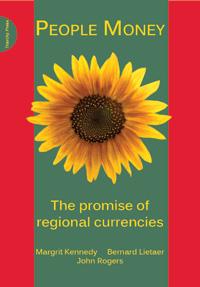People Money: The Promise of Regional Currencies
Margrit Kennedy, Bernard Lietaer, John Rogers, Triarchy Press, UK, julho 2012

People Money is a comprehensive guide to the principles and practice of regional currencies.
It shows how regional currencies can transform the lives and well-being of local communities, how they can sustain businesses, how local authorities can participate in their success and, consequently, why supporting regional currencies is of vital importance to the future of your community, region or country.
It is also a comprehensive guide to the development process and implementation of a regional currency.
Contents
In Part 1, The Case for Regional Currencies, the authors give an excellent overview of the present monetary system – its history and purpose - and an explanation of its inherent weaknesses. They include a short history of regional currencies and their effects, with examples dating back to 1265. (The oldest one in existence today is the WIR bank in Switzerland, now 78 years old with a turnover of the equivalent of 1.627 billion Swiss Francs in 2010.)
The characteristics and purpose of the various models of commercial- and community-oriented currencies are then explained, with examples from rich and poor, urban and rural communities. Different types of currency – voucher systems, circulating currencies, exchange rings and micro-credit banks – are looked at in detail.
A regional currency should ideally:
represent a win-win situation for all participants
be organised with the aim of mutual social benefit
be professionally run
be transparent for its users
be democratically governed
be sustainably financed
contain circulation incentives.
Drawing on the experiences of organisers of regional currencies, the authors describe the administration and governance of the currencies, how to cooperate with other financial institutions, clearing systems and the issue of taxation.
Part 2, Regional Currencies in Practice, focuses on the ‘how to’ of developing a regional currency and the benefits that have accrued as a result of their implementation.
Regional currencies can be started by individuals, businesses or local government authorities. Through years of experience and in-depth interviewing of the organisers of different currencies, the authors have developed a framework of 5 phases for new developers to work from. Each of these phases is clearly explained so that, by the end, currency designers will have a:
Currency mechanism
Cost recovery model
Management structure and key job descriptions
Appropriate governance model
Marketing strategy: a suitable name and the beginnings of a corporate identity
Training needs assessment and plan to recruit ‘multipliers’ who will publicise and explain the concept throughout the region.
Map of other projects in the regional and social economy, which are complementary to the regional currency and could work together
Project presentation portfolio for decision makers and multipliers
Finally, the book profiles of some of the leading organisers of regional currencies around the world, explaining their driving passion and the nuances of each of the models – how the currency started, how it developed, the difficulties encountered on the journey, and how these were overcome.
